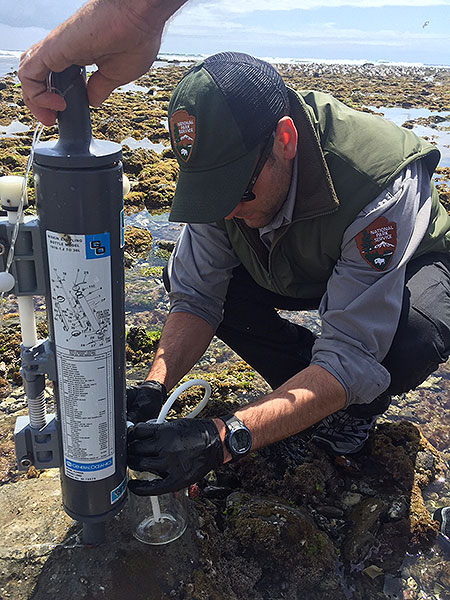News Release

NPS Photo
News Release Date: May 24, 2016
Contact: Eva DiDonato
The NOAA-led West Coast Ocean Acidification (WCOA) cruise started its voyage along the California Current May 5. Its route follows the entirety of the West Coast from Baja California to British Columbia, taking water samples along 13 transects on the way. On each transect, samples of water will be collected at the offshore stations by the on-board scientists, and at nearshore and onshore locations by partnering agencies. All the water samples will be analyzed by NOAA, and the results will give researchers a better understanding of marine health on the West Coast. Scientists aboard the Research Vessel Ronald S. Brown represent several different agencies and educational institutions, and it’s the fifth research cruise of this type since 2007.
Combating Ocean Acidification
Ocean acidification (OA) is a major threat to the health of the Earth’s oceans. It occurs because carbon dioxide from the atmosphere dissolves into oceans and other bodies of water, decreasing the pH—making waters more acidic. This results in less calcium carbonate available for marine organisms, like plankton, coral, lobsters, oysters, and mussels, and they need this carbonate to survive and thrive. The harm and damage from OA spreads throughout the food chain and affects the entire ecosystem.
National Parks Are Involved
This is the first time NPS has collaborated with NOAA on this important research project. Early on May 5, scientists at Cabrillo National Monument, assisted by U.S. Navy partners, collected nearshore water samples at two stations, and park researchers took additional water samples in the intertidal zone on shore. The data from these samples will supplement what the ship collected offshore.
As the Ronald S. Brown continues its voyage along the West Coast, scientists on board will also collect samples near several national park units: Channel Islands NP, Point Reyes NS, Golden Gate NRA, Redwood NSP, San Francisco Maritime NHP, and Lewis and Clark NHP. The data from these stations will help park staff better understand ocean acidification in local marine waters and inform management decisions at these parks. On May 31, the ship’s crew is scheduled to coordinate with NPS scientists at Olympic National Park to collect offshore and nearshore water samples.
This collaborative research cruise will contribute significantly to the bigger picture of ocean acidification in marine waters along the West Coast, connecting offshore environments to the parks’ nearshore habitats. You can follow the WCOA on its blog or on social media with #WCOA2016. For more information about this work and the Ocean and Coastal Resources Branch, contact Eva DiDonato.
Last updated: May 25, 2016
